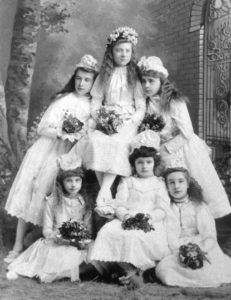
The Fifteenth of August brings my maternal grandmother’s birthday, and since she was born on this day, the Feast of the Assumption, my great grandparents named her Assunta. American neighbors sometimes called her Susan or Suzy, but that just never sounded quite right to me in naming a small, feisty Italian woman who spoke broken English. Grandma always was Assunta, or, as Grandpa would call her, Assu.
This Feast of the Assumption, which marks the ascent of the Virgin Mary body and soul into Heaven, marks other days, as well: the Dog Days of Summer are over today, and it is the great Italian summer holiday of Ferragosto. The waters today are blessed by priests and so most Italians close up shop and head to the sea, some to soak their aches and pains in the blessed waters and others just to swim or float or get a suntan. One thing is certain: work is not a priority today. (We could learn a lot from the Italians.)
Grandma’s birthday and Ferragosto mean, for us, a simple supper of cucuzza longa simmered with eggs. It is hearty peasant fare that is quick and easy to prepare, which makes it the perfect sustenance for the evening of a hot day in late summer, especially when it is paired with a crusty loaf and some wine––perhaps a sparkling white or a rosé, or maybe, if you have someone like Grandpa in your life, a pitcher full of the finest summer peaches, sliced, with red wine poured over them and set in the refrigerator for just a few minutes before dinner is served. This, anyway, will be our Ferragosto dinner. I encourage you to join us.
You’ll need to first get hold of cucuzza longa. This translates to “long squash” and in fact these past two years I’ve found them in markets labeled as just that. They are not a squash at all, but actually an edible gourd, which, left to their own devices, will grow to two or three feet in length and might end up straight as pins or in curls like snakes. In markets, though, where uniformity is prized, chances are you’ll find them looking just like the ones in the photo above. For the locals: I found ours at Doris Italian Market in western Boca Raton (there are a few locations in South Florida; perhaps one near you). Rorabeck’s in western Lake Worth had them last year, but not this year (at least not yesterday). Whether you call them Long Squash or Cucuzza Longa, this is not a vegetable you’ll typically find in the supermarket; it’s definitely a specialty market thing. In a pinch, you can substitute zucchini… but the cucuzza is different and so much better.
Here’s Mom’s recipe to prepare your traditional Ferragosto dinner. She learnt it from Grandma, who learnt it from Mom’s Great Grandma, and so on and so on… which is what I love about a meal like this: It’s not just dinner; it is, as well, a communion with others across time and space, and there is powerful magic in that.
F E R R A G O S T O S U P P E R
3 cucuzza longa
1 large onion
olive oil
1 can crushed tomatoes
8 to 12 eggs
1/2 cup (or more) grated cheese: Romano or Locatelli or Parmigiano-Reggiano
flat leaf parsley, leaves removed from stems
fresh basil
salt & pepper
Wash and peel the cucuzza using a knife or a vegetable peeler, then cut into thick slices, each slice about 3″ long (you’re cutting lengthwise with the cucuzza, as opposed to slicing rounds). Chop the onion roughly and in a large pot, sauté the onion in olive oil until translucent and just beginning to brown. Add the crushed tomatoes to the cooked onion. Let simmer about 10 minutes.
Meanwhile, in a large bowl, beat the eggs with a whisk, then add the parsley and grated cheese. (A note here about measurements: recipes like these, handed down from generation to generation, don’t come with precise measurements. You put a handful of this, a pinch of that. As Grandma would say (though she would say it in her Lucerine dialect): The more you put, the more you find.) Once the tomato/onion mixture has simmered, add about one quarter of the sliced cucuzza, followed by about one quarter of the egg and cheese mixture. Continue layering cucuzza and the egg mixture until everything is in the pot. Add a handful of fresh basil leaves; season with salt and pepper. Simmer, covered, without disturbing, until the egg is set and the cucuzza is tender (about an hour, maybe less).

All the ingredients, in the pot, about to be simmered.
This one-pot summer meal will serve 6 to 8, especially if it’s served alongside warm, crusty bread, and perhaps a simple salad of escarole dressed with olive oil, wine vinegar, and salt. It’s delicious. And it was on our table pretty much each and every one of Grandma’s birthdays. Grandpa certainly loved it. He would have eaten his Ferragosto supper and then made a simple hand gesture, his finger pushed into his cheek with a forward twisting motion, proclaiming it Saporite!



